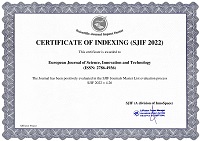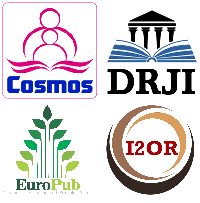Tolerance of Banana and Plantain Cultivars (Musa spp.) against the Epidemiology of BBTV, Grown in Open Fields, Maniema, DR Congo
Abstract
The objective of the study was to evaluate the expression of banana and plantain (Musa spp.) cultivars grown in the open field in the face of the epidemiology of BBTV, Maniema, DR Congo. Specifically, to determine which banana and plantain (Musa spp.) cultivars are resistant, tolerant and sensitive to the epidemiology of BBTV. To achieve the objective, methods relating to the latter were used. A single factorial design of elongated plots with 11 repetitions and 11 cultivars of banana and plantains was set up. The spacings chosen were 3 m x 3 m, i.e. a density of 121 feet in a field of 40 m x 40 m. Thus, the results obtained showed that from the TAS ELISA in the presence of the vector (Pentalonia nigronervosa) the plants of banana and plantain cultivars with or without symptoms of BBTD are sometimes carriers of the banana bunchy top virus (i.e. 24.28%). There is a strong correlation between plant-vector-disease-production, that is to say; plants carrying aphid colonies are likely to be more infected by BBTV and cause significant yield losses. The correlation between production, incidence and severity makes it possible to uncover the resistance and tolerance of cultivars to BBTV. The cultivars Kamboloso, Lokoka, Yangambi Km 5 and Tala lola having achieved excellent yields are said to be resistant to bunchy top disease, their severity in the TAS ELISA oscillated between 0-10% of the general scale for evaluating viral diseases. Furthermore, the cultivars Libanga likale, Leese, Andula, Lokusu, Losakala and Nguku are tolerant to BBTD given that they obtained good yields and their ELISA severity level evolved between 11-40% and finally, the Kamaramasenge cultivar is sensitive to BBTD because it achieved an intermediate yield and a severity level varying between 41-75% of the general scale assessment of viral diseases. This study clearly confirms that there is a positive effect of aphid bite inoculum on virus transmission in banana and plantain cultivars grown in the open field. We recommend that genetic improvement studies be carried out by other researchers to explore the resistance and tolerance genes found in the cultivars Kamboloso, Lokoka, Yangambi Km 5, Tala lola, Libanga likale, Leese, Andula, Lokusu, Losakala and Nguku for better cultural control of BBTV and an improvement in the productivity of bananas and plantains in the sub-region of Africa to the east of the RD Congo in particular and throughout the world in general.
References
Anhalt, M.D., & Almeida, R.P.P. (2008). Effect of temperature, vector life stage, and plant access period on transmission of Banana bunchy top virus to banana. Phytopatholgy, 98, 743 – 748.
Benhamou, N. (1993). Spatio-temporal régulation of defence gènes : immunocytochemistry. In B. Fritig & M. Legrand (Eds.), Mechanisms of plant défense responses (pp. 221-235). Kluwer Acad. Press, Dordrecht.
Benhamou, N. (1996). Elicitor-induced plant défense pathways. Trends Plant Sci., 1, 233 240.
Benhamou, N., Gagné, S., Le Quéré, D., & Dehbi, L. (2000). Bacterial-mediated induced resistance in cucumber: beneficial effect of the endophytic bacterium Serratia plymuthica on the protection against infection by Pythium ultimum. Phytopathology, 90(1), 45-56.
Bola, M. (2013). Essai d'assainissement de bananier plantain du groupe génomique AAB (Cultivars du type faux corne : Libangalikale et du type frensh : Litete) infecté par le Banana Bunchy Top Virus (BBTV) par la culture in vitro.
Busogoro, J.P., Dutrecq, O., & Jijakli, H. (2009). Development of simple molecular protocols to detect Banana bunchy top virus with the PhytoPass System. Acta Horticulturae ISHS, 828, 213-218.
Caruana, M.L. (2003). Analyse du Risque Phytosanitaire (ARP). Bananiers. Banana Bunchy Top babuvivus. CIRAD.
CIAT. (1987). Comité International d’Accompagnement de la Transition.
CIRAD-FLHOR. (1996). Screening for résistance to banana Bunchy Top in Rwanda, (Centre de Coopération Internationale en Recherche Agronomique pour le Développement, Département des Productions Fruitières et Horticoles).- Montpellier (France): ISBN 2-87614-108-6. p. 378.
CIRAD. (2019). Maladies et ravageurs du bananier. Fruitrop, 231, 85 – 97.
CTCPM. (2002). Mineralogie de la RDC et son Histoire, Archive: Cellule Technique de Coopération et de plannification Minière (ctcpm.minimnes@ic.cd, consulté le 27/05/2022)
Dhed’a Djailo, B., Adheka Gira, J., Onautshu Odimba, D. & Swennen, R. (2019). La culture des bananiers et plantains dans les zones agroécologiques de la République Démocratique du Congo. Presse universitaire, Unikis, 72p.
Dowiya, N. B., Rweyemamu, C. L. & Maerere, A. P. (2009). Banana (Musa spp. Colla) cropping systems, production constraints and cultivar preferences in Eastern Democratic Republic of Congo. Journal of Animal & Plant Sciences, 4(2), 341 - 356.
FAOSTAT. (2018). Food and agriculture Organization of the United Nations.
Frison, E. & Sharrock, S. (1999). The economic, social and nutritional importance of banana. In C. Picq, E. Fouré & E. Frison (Eds.), Bananas and food security, Proceedings of an International Symposium. Douala, Cameroon, 10-14 November 1998. INIBAP, Montpellier, France.
Gira, A. & De Langhe, E. (2018). Characterization and classification of the Musa AAB plantain subgroup in the Congo basin. Scripta Botanica Belgica, 54.
Kagy, V., Thomas, J.E., Sharman, M., & Mademba-Sy, F. (2001). First record of banana bunchy top disease in New Caledonia. Aust Plant Pathol., 30, 71.
Makondambuta, E. (1997). Les types de climat. Congoneline. Afriqu'Info asbl, Bruxelles, Belgique.
Mobambo, K.N., Staver, C., Hauser, S., Dheda, B. & Vangu, G. (2010). An innovation capacity analysis to identify strategies for improving plantain and banana productivity and value addition in the Democratic Republic of Congo. Acta Horticulture (ISHS), 879, 821-827.
Mobambo, K.N., Zuofa, K., Gauhl, F., Adeniji, M.O., & Pasberg-Gauhl, C. (1994). Effect of soil fertility on host response to black leaf streak of plantain (Musa spp., AAB group) under traditional farming systems in southeastern Nigeria. International Journal of Pest Management, 40, 75- 80.
Mukwa, L. F. T., Muengula, M., Zinga, I., Kalonji, A., Iskra Caruana, M. L., & Bragard, C. (2014). Occurrence and Distribution of Banana bunchy top virus Related Agro-Ecosystem in South Western, Democratic Republic of Congo. Am. Journ. Pl. Sci., 5, 647-658. http://dx.doi.org/10.4236/ajps.2014.55079
Nelson, S.C. (2004). Banana bunchy top; detailed signs and symptoms, College of Tropical Agriculture and Human Resources (UHCTAHR), University of Hawaii. Banana Bunchy Top Virus. Disease spread and development. Available online: http://www.ctahr.hawaii.edu/bbtd/downl oads/BBTV-details.pdf
Ngama, B.J.F. (2010). Etude diagnostique de banana Bunchy top disease (BBTD) dans la région forestière du bassin du Congo en district de la Tshopo dans la province orientale en RDC. Mémoire de DES, inédit IFA Yangambi.
Ngama, B.J.F. (2015). Distribution et épidémiologie de la maladie virale du sommet touffu de bananier (BBTD) dans le bassin du Congo en Province Orientale (R.D. Congo). Thèse, Inédit, UNIKIS. P.64.
Niyongere, C., Losenge, T., Ateka, E. M., Nkezabahizi, D., Blomme, G., & Lepoint, P. (2012). Occurrence and distribution of banana bunchy top disease in the Great Lakes region of Africa. Tree and Forestry Science and Biotechnology, 6(1), 102-107.
Nzawele, D. (2012). Distribution and genetic variation of eastern Democratic Republic of Congo’s Musa spp. Colla and their relatedness with those in Tanzania. Dissertation for Award of PhD Degree of Sokoine University of Agriculture. MOROGORO, TANZANIA. 259p.
Ondh-Obame, J. A., Ndong, A. N., Ndoutoumou, P. N., Assembe, P. C. M., Minko, I. D. M., & Bello, K. P. (2020). Prévalence du Banana Bunchy top disease (BBTD) dans la zone de Ntoum au Gabon. International Journal of Biological and Chemical Sciences, 14(3), 739-749.
Ondh-Obame, J. A., Nguema, P., BayendI, S. M., Oye Anda, C.C., & Ndoutoume, A. (2021). Variabilité de la sensibilité vis-à-vis du Banana Bunchy Top Virus (BBTV) des espèces de Musa spp. Cultivées dans le Grand Libreville. International Journal of Scientific Research, 10(12).
Qazi, J. (2016). Banana bunchy top virus and the bunchy top disease. J Gen Plant Pathol., 82(1), 2-11. DOI: 10.1007/s10327-015- 0642-7
Robson, J.D., Wright, M.G., & Almedia, R.P.P. (2007). Biology of Pentalonia nigronervosa (Hemiptera, Aphididae) on banana using different rearing methods. Environ Entomol., 36, 46–52.
Shadari, S. (2022). Distribution spatiale de la maladie du sommet touffu de bananiers (BBTD) dans les différentes zones de production bananière en Province de Maniema, RD Congo, mémoire /DES/Université de Kisangani, inédit. 147p.
Shadari, S., Mukandama, N., Ngama, B., & Salumu, D. (2023). Spatial Distribution of Banana Tough Top Disease (BTTD) in Maniema Province, DR Congo. European Journal of Science, Innovation and Technology, 3(4), 184-202.
Swennen, R., & Vuylsteke, D. (2001). Bananier. In Raemarkers H.R. (Ed.), Agriculture en Afrique Tropicale, DGCI: Bruxelles; 611636.
Thomas, J.E., Geering, A.D.W., Dahal, G., Lockhart, B.E.L., & Thottappilly, G. (2003). Banana and plaintain. In G. Loebenstein & G. Thottappilly (Eds.), Virus and Virus-Like Diseases of Major Crops in Developing Countries (pp. 477–496). Kluwer: Dordrecht.
Tollens, E. (2004). Les défis : Sécurité alimentaire et cultures de rente pour l‟exportation-Principales orientations et avantages comparatifs de l‟agriculture en R.D.Congo." Working Paper, n° 86, Département d'Economie Agricole et de l'Environnement, Katholieke Universiteit Leuven, 76p.
Van Der Plank, J.E. (1968). Résistance des plantes aux maladies. Academic Press Inc., New York and London.
Wickramaarachchi, W. A. R. T., Shankarappa, K. S., Rangaswamy, K. T., Maruthi, M. N., Rajapakse, R. G. A. S., & Ghosh, S. (2016). Molecular characterization of banana bunchy top virus isolate from Sri Lanka and its genetic relationship with other isolates. VirusDisease, 27, 154-160.
Yoshikawa, M., Yamaoka, N., & Takeuchi, Y. (1993). Elicitors: their significance and primary modes of action in the induction of plant defense reactions. Plant Cell Physiol., 34, 1163-1173.
Copyright (c) 2024 Shadari Salumu, Dowiya Nzawele, Mukandama Ndolandola

This work is licensed under a Creative Commons Attribution 4.0 International License.


 ISSN
ISSN 











